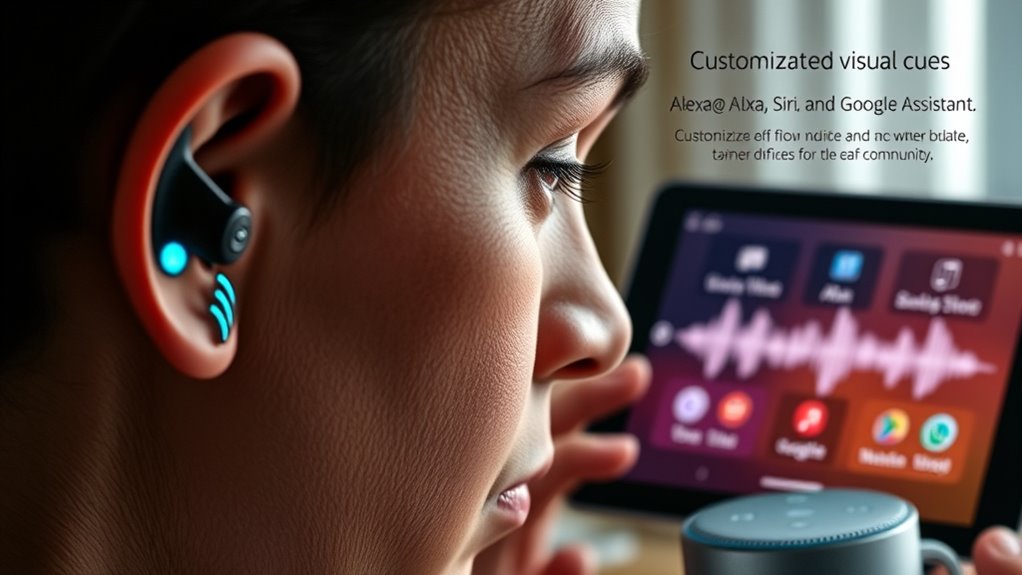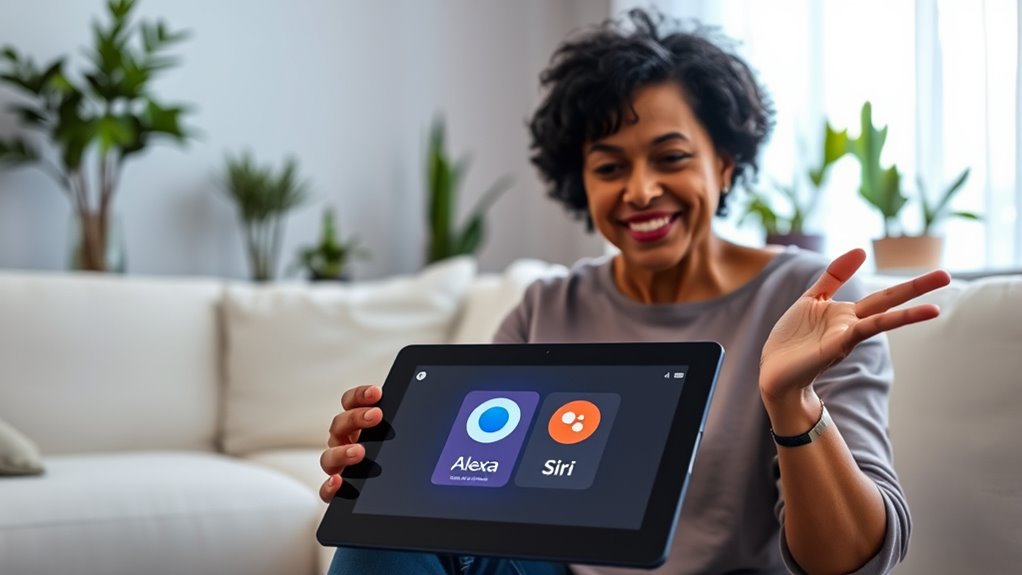You can customize Alexa, Siri, and Google Assistant to better support deaf users through features like sign language recognition, visual notifications, and text displays. These assistants allow you to enable visual alerts for messages, reminders, or calls, and some offer live captioning or sign language translation. You’ll also find options to control smart home devices visually or through vibrations, making interactions more accessible. Keep exploring these options to discover how to optimize your experience even further.
Key Takeaways
- Enable sign language recognition and translation features within Alexa, Siri, and Google Assistant for natural communication.
- Customize visual notifications like flashing lights, on-screen text, and vibrations to alert deaf users effectively.
- Use device settings to display live captions and text-based alerts during interactions or incoming messages.
- Integrate third-party apps that convert speech into sign language videos for enhanced understanding.
- Adjust notification preferences and accessibility options to tailor the assistant’s responses and alerts to individual needs.

Voice assistants are transforming communication for the deaf by providing real-time, accessible support that bridges gaps in traditional interaction. When you consider how these tools can be customized, especially with features like sign language integration and visual notification systems, they become powerful allies in enhancing independence and connectivity. Sign language integration allows you to communicate more naturally with your device, either through sign language recognition or by translating spoken commands into sign language. This helps minimize misunderstandings and makes interaction more seamless, especially if you’re more comfortable expressing yourself visually. Devices like Alexa, Siri, and Google Assistant are increasingly incorporating these features, either directly or through third-party apps, so you can engage with them in a way that feels intuitive.
Voice assistants enhance accessibility for the deaf with sign language and visual notifications, fostering independence and seamless communication.
Visual notification systems are another critical aspect of making voice assistants more accessible for deaf users. Instead of relying solely on sound alerts, these systems use visual cues such as flashing lights, on-screen text, or vibration alerts to notify you of incoming messages, reminders, or important updates. This way, you don’t miss out on essential information, whether it’s a calendar reminder or a notification from a smart home device. You can customize these visual cues to suit your preferences, ensuring you’re always aware of what’s happening around you without needing auditory signals. These visual alerts are particularly useful in noisy environments or situations where sound isn’t practical, allowing you to stay connected and informed at all times.
By integrating sign language and visual notification systems, voice assistants become more inclusive and user-friendly. For example, you might set your device to display text notifications on the screen or use a smart display device that shows live captions of voice commands or conversations. This visual support helps you understand interactions better and provides reassurance that your commands are being recognized accurately. Additionally, some platforms support third-party apps that convert speech into sign language videos, enabling real-time visual communication with others. These features collectively empower you to control your environment, access information, and communicate effectively, all tailored to your specific needs.
Ultimately, customizing voice assistants with sign language integration and visual notification systems ensures that your interaction is not only functional but also comfortable and accessible. It bridges communication gaps, fosters independence, and creates a more inclusive digital experience. As these technologies continue to evolve, your ability to connect with the world through voice assistants will only become more natural, intuitive, and tailored to your way of communicating.
Frequently Asked Questions
How Can Voice Assistants Improve Communication for the Deaf?
You can improve communication for the deaf by using voice assistants with features like sign language translation and visual notification settings. These tools let you receive alerts visually and understand spoken words through sign language, making interaction more accessible. By customizing these settings, you guarantee you’re always connected and informed, reducing communication barriers and enhancing independence in everyday situations.
Are There Specific Features Tailored for Deaf Users?
Imagine it’s 1984, and technology is just beginning to change lives. Today, you find that voice assistants have tailored features for deaf users, like sign language translation and customized accessibility options. These features help you communicate more effectively, whether through visual cues, text-based responses, or sign language integration. You can personalize these tools to better suit your needs, making everyday tasks more accessible and inclusive.
Can Voice Assistants Recognize Sign Language?
You wonder if voice assistants can recognize sign language. Currently, they mainly focus on gesture recognition and sign language translation, but full recognition isn’t widespread yet. Some devices experiment with cameras and AI to interpret gestures, helping deaf users communicate more easily. However, these features are still evolving, and most voice assistants don’t fully support sign language recognition, so relying on visual or specialized tools remains essential for effective communication.
What Privacy Concerns Exist With Deaf-Friendly Voice Tech?
They say “trust is earned,” and with deaf-friendly voice tech, privacy concerns are real. You might worry about data encryption and whether your user consent is truly respected. These devices collect sensitive info, so it’s essential they use strong data encryption and clearly ask for your permission. Always stay vigilant, read privacy policies, and understand how your voice data is stored and shared to keep your privacy intact.
How Do Voice Assistants Integrate With Visual Alert Systems?
You can customize visual alert systems by adjusting accessibility settings on your device. Voice assistants like Alexa, Siri, and Google integrate with these systems through features like visual notifications, flashing lights, or screen alerts. By enabling and personalizing visual alert customization, you guarantee important notifications are accessible, making your environment more inclusive. This seamless integration helps you stay informed through visual cues, enhancing overall accessibility for deaf or hard-of-hearing users.
Conclusion
By customizing voice assistants like Alexa, Siri, and Google, you open doors to greater independence and better communication. These tools are more than just gadgets; they’re game-changers that can bridge gaps and make daily life smoother. Remember, when it comes to assistive technology, you get out of it what you put in. So, don’t be afraid to tailor these devices to fit your needs—after all, it’s your life, and you’re the one calling the shots.











